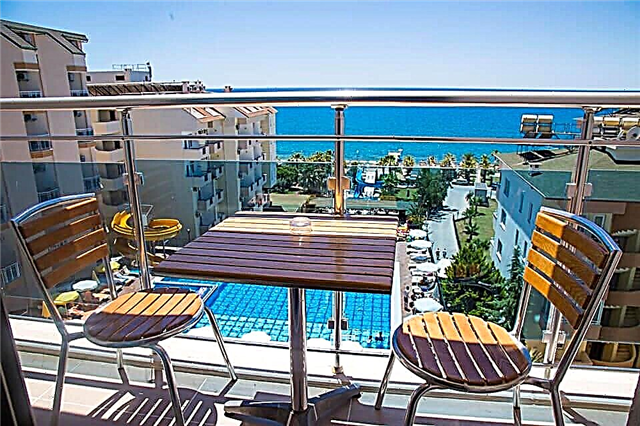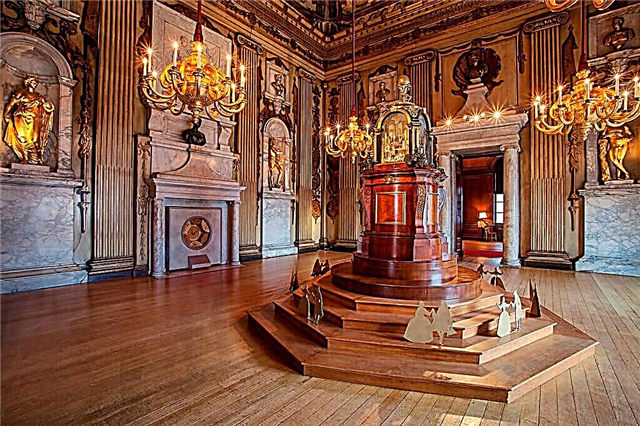Kensington Palace served as the official royal residence for a short time during the reign of George II (18th century). Its history is less known than other apartments of the British monarchs - the Tower of Fortress, Buckingham Palace, Windsor Castle.
Construction history
The territory in the west part of London was in the possession of the Earl of Nottingham, who built for his needs in 1605 a small country palace in the form of a 3-storey building. William III liked the location of the palace, far from the noisy center of the capital. In addition, the king suffered from asthma, and the fresh air was good for his health. As a result of the deal, Kensington Palace passed to the royal family.
By order of William, the famous architect Christopher Wren, the creator of St. Paul's Cathedral, was engaged in the arrangement of the residence for the needs of the royal court. The architect decided not to rebuild the building, but to expand it with galleries, outbuildings, stairs. Under his leadership, the following were created: King's apartments, main staircase, clock tower, chapel. One of the first high-ranking guests to visit Kensington was the Russian Tsar Peter I. A portrait by Gottfried Kneller that adorns the gallery remains in his memory.
However, the king and queen failed to fully enjoy the pleasures of life in the new residence. They died a short time after the move. The palace also turned out to be an unlucky place for Queen Anne. All 17 offspring of the royal family died within its walls. Since then, Kensington has earned a reputation as a cursed place.
Anna's reign is marked by the emergence of a park and greenhouses. The famous follower of the Baroque style, the architect John Vanbruh, was engaged in their breakdown. Significant improvements to the palace grounds were made by order of George I. The work was supervised by William Benson. In accordance with his project, the building was renovated, a secret chamber and a royal living room were built.
The new monarch George I made Kensington Palace his main headquarters. He was the only ruler of England who lived in Kensington for a long time. On May 24, 1819, the daughter of the Duke of Kent, Alexandrina Victoria, was born here, who went down in British history under the name of Queen Victoria. The monument in the garden and the exposition "Unknown Victoria", located in the exhibition part of the castle, remind of a significant event in the history of the palace.
After her coronation, Victoria left the palace. He began to decay and fall into desolation. To remedy the situation, the queen ordered the opening of the apartment for public inspection. Thus, from the end of the 19th century. Kensington Palace is partially a museum.
Half of the territory remains residential. Here in the 80s and 90s. biennium In the 20th century, Crown Prince Charles lived with his wife Princess Diana and children. After Lady Dee's tragic death, her apartment has undergone changes. It was decided to completely re-equip them in order to exclude theft of items for sale at auctions.
Currently, the complex of structures of the Kensington Palace is conditionally divided into 2 parts:
- Exhibition, where guided tours and permanent exhibitions operate.
- Residential, where the younger members of the royal family live.
The small, humble Kensington Palace serves as a permanent residence for:
- families of the Duke and Duchess of Gloucester
- families of the Duke and Duchess of Kent
- for the family of the Duke and Duchess of Cambridge
Private rooms are occupied by Prince Harry.
Reception hall

Under King George II, the main premises of the palace was the reception hall. It hosted solemn meetings of the monarch with his subjects, as well as audiences with representatives of foreign powers.
In 1734, this room hosted a presentation to the British royal court of the Indian chief Yamacraw. He came from the English colony of Georgia in the New World.
In the reception hall in a prominent place is the armchair of the son of George II - Friedrich, covered with gilding.
Queen's apartment

The royal apartments consist of an enfilade of halls, passages, galleries. The premises are richly decorated with works of art. Some of them have preserved historical artifacts that belonged to British monarchs in the 18-19 centuries:
- Gallery - a collection of porcelain, embroidery, Turkish carpets;
- Dining room - wood carved wall panels;
- The bedroom is a baby cradle in Queen Victoria gold;
- The Red Salon is the venue for the 1st State Council after Victoria's accession to the throne.
The Queen's suite also includes a boudoir, living room, stairs to the garden.
Central Park Hotel
London
Located less than 100 meters from Hyde Park

Hotel Edward Paddington
London
Minutes from Paddington Station and Hyde Park

DoubleTree by Hilton London - Docklands Riverside
London
Located on the embankment of the Thames

Park Plaza County Hall London
London
Just minutes from the banks of the Thames and the London Eye

Wardrobe of kings
The royal wardrobe was established at the end of the 17th century. by order of Queen Anne. A room designed for storing clothes and accessories should not have been conspicuous for visitors. Therefore, the entrance to it was disguised among the paintings on the walls of the hall.
Living room

Among other premises that belonged to King George II, the living room stands out. She served as a magnet attracting courtiers and nobles who sought to merit a personal meeting with the monarch.
There is no furniture in the room, since the king was supposed to be greeted standing. Pictures serve as the main decoration of the hall. The most famous painting is Venus and Cupid by the Italian painter Giorgio Vasari.
Royal staircase

The route to the Reception Hall follows the marble Royal Staircase. This is one of the most remarkable places in Kensington Palace. Initially, the walls along the steps were covered with wood paneling, made in 1724 from designs by Christopher Wren.
In the 18th century, they were replaced by paintings by William Kent. The artist depicted palace life on canvases and captured many real characters. The idea to decorate the passage with painting, Kent borrowed from the Italians. There are also sculptures on the wall - copies of real statues of ancient times. So, at the top of the staircase, a statue of Diana is reproduced. Its original is on display at Holkham Hall in Norfolk.
Gardens
Initially, a dense forest grew on the site of the current Kensington Gardens. Its proximity to the capital and abundance of wild animals attracted the attention of kings. The territory has received the status of royal hunting grounds. It was fenced in and banned from the general public.
After William III bought Kensington Palace at the end of the 17th century, it was decided to build a garden with him. The planning of the park landscape was done by Christopher Wren. In the Annensky era, the gardens were expanded at the expense of sections of Hyde Park. It was also decided to build a greenhouse for exotic plants.
The next stage in the development of gardens was the Georgian period. The spouse of George II, Caroline, paid a lot of attention to the improvement of the park territory. According to her orders, a cascade of artificial reservoirs appeared in the gardens: Dolgoe Lake, Serpentin Lake, Round Pond. For relaxation among the greenery, 2 wooden gazebos were erected. One of them, called "Temple of the Queen", has survived to this day.
In 1860, the English layout of the gardens was supplemented with a new interesting corner, called the Italian Gardens. It includes the bowls of 4 pools surrounded by numerous sculptures. Queen Victoria contributed to the design of Kensington Gardens. After the death of her husband, she ordered to perpetuate his memory with a giant memorial (54 m in height). It took 10 years to build the structure. The opening of the monument took place in 1872.

Significant sites in Kensington Gardens include:
- Albert Hall - concert hall
- Kensington Roof Gardens - Restaurant
- Sculpture of a boy by Peter Pan
- A playground with a 900-year-old oak tree.
In 1909, at the request of Edward VII, a corner of the park was turned into the Secret Garden, which resembled the Dutch gardens of the 17th century. For walks to the general public, the park opened its gates in 1728. Entrance to the territory is free and open throughout the year.
Coca-Cola London Eye Ticket - £ 24.30
Tower of London and Royal Treasure Exhibition Ticket - £ 26.80
Tower Bridge Ticket - £ 9.80
Westminster Abbey entrance ticket and audio guide - £ 20
Madame Tussauds ticket - £ 29
St Paul's Cathedral Fast Track Ticket - £ 16
Skyscraper "Shard" - entrance ticket and champagne - £ 24.95
Moving Prince William and Kate Middleton
The Kensington Palace caused a new surge of public interest after Prince William and his wife and children decided to settle in it. The couple chose the former rooms of Princess Margaret, which had been closed since her death in 2002. To restore the chambers, it was necessary to spend St. £ 1 million. The expenses were paid from the state budget, since the palace is included in the register of historical monuments.
Furniture and furnishings of the Dukes of Cambridge, with the permission of Elizabeth II, were selected from the royal collection. The move took place in 2013.
The couple and their children have at their disposal:
- 5 bedrooms
- 3 living rooms
- office space
- kitchen
- rose garden
Kensington Palace is open to the public all year round (except 24.12-26.12), but opening hours vary depending on the season.
| Period, dates | Winter (1.11-28.02) | Summer (1.03- 3110) |
| Working hours | Monday - Sunday: 10.00 - 16.00 | Monday-Sunday: 10.00-18.00 |
| Last entrance | 15.00 h. | 17.00h. |
Tickets must be purchased to view the apartments and the surrounding area. They are of 3 types:
- Children: 5 to 15 years old. Children are admitted only if accompanied by an adult
- Adult: over 16 years old
- Preferential: full-time students, seniors (60 years old)
The ticket price, at the request of the visitor, may include an additional surcharge of 10%. It is a voluntary donation to the needs of the museum.
| Ticket type | No donation | With donation |
| Child | Is free | Is free |
| Adult | 15,5 £ | 17,10 £ |
| Preferential | 12,30 £ | 13, 60 £ |
The HRP card also gives the right to enter the palace. It is paid once and provides unlimited access to 6 Royal Palaces in London. Membership prices from March 01, 2018: Individual (1 adult) - £ 52.00, Shared (2 adults) - £ 80.00, Family (1 adult and up to 6 children) - £ 74.00, Family group (2 adults and up to 6 children) - £ 105.00.
There is no audioguide around the palace, therefore, visitors conduct the inspection independently, guided by the guidebook, or together with a pre-ordered guide. The story is in English.
Where is it located and how to get there
The coordinates of the Kensington Palace are London W8 4PX UK.
The trip can be done by metro or bus.
Metro stations:
- Queensway - Central Line (10-15 minutes walk)
- High Street Kensington - Circle & District Lines (10-15 minutes walk)
- Notting Hill Gate - Center, Circle & District Lines (20-25 minutes walk)
Bus routes:
- to Bayswater Road - 70, 94, 148, 390
- to Kensington High Street - 9, 10, 49, 52, 70, 452
In summer, a bicycle is a convenient way to get around.











